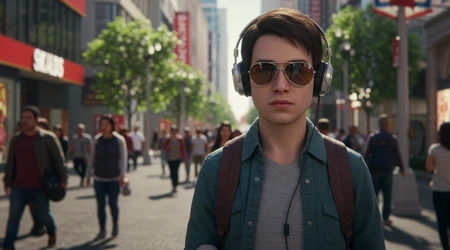Using Public Spaces When You Have a Sensory Processing Disorder

Sensory processing disorder can make navigating public spaces feel like walking through a storm of sensations. Imagine a bustling mall: fluorescent lights hum, voices overlap, and scents clash.
For someone with sensory processing disorder, this isn’t just noise it’s a sensory overload that can trigger anxiety or withdrawal.
Public spaces, designed for the masses, often overlook the needs of those with sensory challenges. Yet, with awareness and strategies, these environments can become more accessible.
This article explores how individuals with sensory processing disorder can thrive in public settings, offering practical solutions, real-world examples, and insights grounded in current understanding.
Why should sensory inclusivity matter to everyone? Because accessible spaces benefit us all.
Public spaces airports, parks, libraries, or cafes are hubs of community life. However, for the estimated 5-16% of children and adults with sensory processing disorder, these places can be daunting.
According to a 2013 study published in Frontiers in Integrative Neuroscience, sensory processing disorder affects how the brain interprets sensory input, leading to over- or under-responsiveness.
This condition, often linked with autism but also occurring independently, disrupts daily functioning. Inclusive design and personal coping strategies can bridge this gap, ensuring public spaces are welcoming for everyone.
This article dives into understanding sensory processing disorder, its challenges in public environments, and actionable solutions.
From sensory-friendly venues to self-regulation techniques, we’ll cover tools to make public spaces less overwhelming.
Real-life examples and a data-driven approach will ground our discussion, with a focus on 2025’s advancements in accessibility.
Understanding Sensory Processing Disorder
The brain is like a traffic controller, directing sensory signals sight, sound, touch to create coherent experiences. For those with sensory processing disorder, this system misfires.
Sounds may feel painfully loud, or textures unbearable. The disorder manifests in three subtypes: sensory modulation, sensory-based motor, and sensory discrimination disorders, each affecting how individuals interact with environments.
Sensory modulation issues cause over- or under-reactions to stimuli. A crowded subway might feel suffocating. Sensory-based motor challenges impact coordination, making navigating busy spaces tricky.
++ Why Trauma-Informed Education Supports Accessibility Goals
Sensory discrimination difficulties hinder interpreting sensory details, like distinguishing a friend’s voice in a noisy cafe. These challenges vary widely, requiring tailored approaches.
Public spaces rarely account for these needs. Bright lights, echoing sounds, and unpredictable crowds amplify discomfort.
Understanding these subtypes helps individuals and caregivers prepare for public outings, turning chaotic environments into manageable ones with the right tools.

Challenges in Public Spaces
Picture a grocery store: buzzing carts, flickering lights, and chatter. For someone with sensory processing disorder, this is a sensory minefield.
Overstimulation can lead to meltdowns or shutdowns, where the brain seeks escape. Crowded spaces like malls or transit hubs intensify this, as multiple stimuli compete for attention.
Under-responsiveness poses risks too. Someone might not notice a honking car in a busy parking lot, endangering safety.
Sensory discrimination issues complicate tasks like finding a seat in a noisy theater, as spatial awareness falters. These challenges aren’t just inconvenient they limit participation.
Also read: Accessibility in Daily Banking: Apps That Help
Social stigma adds another layer. A meltdown might be mistaken for misbehavior, drawing judgment.
JWoww, a public figure, shared in a 2025 Mother.ly article how her son’s airport meltdown led to advocacy for sensory-inclusive spaces. Public misunderstanding often isolates those affected.
Physical barriers, like lack of quiet zones, exacerbate issues. Most public spaces prioritize efficiency over inclusivity, ignoring sensory needs. Recognizing these hurdles is the first step to creating solutions that empower individuals.
Strategies for Navigating Public Spaces
Preparation is key to managing sensory processing disorder in public. Start with a sensory checklist: identify triggers like loud noises or bright lights.
Apps like KultureCity’s sensory inclusion tool, updated in 2025, help locate sensory-friendly venues with quiet rooms or dimmed lighting.
Noise-canceling headphones or earplugs can mute overwhelming sounds.
For example, Emma, a 12-year-old with sensory processing disorder, uses custom earplugs at concerts, allowing her to enjoy music without distress. Weighted vests or fidget tools also help regulate sensory input discreetly.
Read more: Shopping Online with a Disability: The Good and the Bad
Plan visits during off-peak hours. A quiet morning at a museum feels less chaotic than a weekend rush.
Pre-mapping routes or exits reduces anxiety, offering control in unpredictable settings. These strategies turn daunting outings into manageable experiences.
Visual schedules help, too. Before visiting a zoo, Sarah, a mother, creates a picture-based itinerary for her son, outlining breaks.
This predictability soothes his sensory overwhelm. Caregivers can also carry sensory kits think sunglasses or stress balls for quick relief.
Technology aids navigation. In 2025, apps like Sensory Friendly Finder list venues with accommodations like low-sensory hours.
Pairing these tools with personal strategies creates a safety net, making public spaces feel less like a battlefield.
Sensory-Friendly Public Spaces in 2025
Across the globe, sensory-friendly initiatives are growing. Airports like Atlanta’s Hartsfield-Jackson now offer sensory rooms with soft lighting and calming textures, a trend expanding in 2025.
Museums, like the Smithsonian, host low-sensory days, reducing noise and crowds for accessibility.
Retail chains are adapting, too. Target introduced sensory-friendly shopping hours in 2024, continuing into 2025, with dimmed lights and quieter announcements.
These changes benefit not just those with sensory processing disorder but anyone seeking calmer environments.
Community advocacy drives progress. Organizations like the Autistic Self Advocacy Network (ASAN) push for universal design, ensuring spaces accommodate diverse needs.
Their 2024 guidelines, still relevant, emphasize quiet zones and clear signage in public venues.
Local libraries are joining the trend, offering sensory-friendly story times with reduced stimuli.
These spaces allow individuals to engage without fear of overload. However, availability varies, so checking venue websites or apps is crucial.
The table below highlights examples of sensory-friendly accommodations in public spaces as of 2025:
| Venue Type | Accommodation | Example Location | Details |
|---|---|---|---|
| Airport | Sensory Room | Hartsfield-Jackson, Atlanta | Soft lighting, calming textures, quiet space |
| Retail | Sensory-Friendly Hours | Target, Nationwide | Dimmed lights, reduced noise, trained staff |
| Museum | Low-Sensory Days | Smithsonian, Washington D.C. | Limited crowds, quieter environments |
| Library | Sensory Story Time | Seattle Public Library | Reduced stimuli, adaptive storytelling |
These initiatives show progress, but gaps remain. Rural areas often lack such accommodations, pushing advocates to demand broader access. Supporting these efforts ensures inclusivity grows.
Advocacy and Community Support
Change starts with voices demanding it. Advocacy groups like ASAN empower individuals with sensory processing disorder to self-advocate, teaching them to communicate needs confidently.
Workshops in 2025 focus on navigating public spaces with assertiveness.
Caregivers play a vital role, too. Online communities, like X’s sensory parenting groups, share tips on managing public outings. These platforms foster connection, reducing isolation for families facing sensory challenges.
Businesses are listening. In 2025, KultureCity trained over 1,000 venues worldwide in sensory inclusion, per their annual report.
Employees learn to recognize sensory needs, creating welcoming environments. This training shifts public spaces toward empathy.
Individuals can advocate, too. Requesting accommodations, like quieter seating at events, sparks change. When Emma’s family asked a local theater for sensory-friendly showtimes, the venue piloted a program, benefiting others.
Public awareness campaigns, amplified on platforms like X, highlight sensory needs.
Hashtags like #SensoryInclusion trend in 2025, spreading real-time stories of progress. Joining these conversations drives systemic change, making public spaces truly inclusive.
The Role of Technology in Accessibility
Technology is a game-changer for sensory accessibility. Wearable devices, like 2025’s SensoryFit wristbands, monitor stress levels, alerting users to potential overload. These tools empower proactive self-regulation in chaotic settings.
Mobile apps enhance independence. Sensory Friendly Finder, updated in 2025, maps sensory-safe venues globally, from cafes to transit hubs. Users can filter for features like quiet zones or low lighting.
Virtual reality (VR) offers innovative solutions. VR programs simulate public spaces, helping individuals practice coping strategies.
For example, a 2025 pilot by Autism Speaks used VR to prepare teens for crowded malls, reducing anxiety.
Smart glasses, like those from Envision in 2025, provide real-time audio cues for navigation, aiding those with sensory discrimination issues. These advancements make public spaces less intimidating, fostering confidence.
However, technology isn’t universal. Cost and access limit adoption, especially in underserved communities. Advocacy for affordable solutions is critical to ensure tech-driven inclusivity reaches everyone.
Building a Sensory-Inclusive Future

Creating sensory-inclusive public spaces requires collective effort. Urban planners must prioritize universal design think dimmable lights or sound-absorbing materials. These changes benefit everyone, not just those with sensory needs.
Education is crucial. Schools and workplaces should teach sensory awareness, reducing stigma. In 2025, some U.S. schools integrate sensory inclusion in curricula, fostering empathy in young generations.
Policy changes drive progress. Advocating for laws mandating sensory accommodations, like quiet zones in public buildings, ensures lasting change. Australia’s 2024 sensory inclusion mandate sets a global example.
Individuals can contribute, too. Supporting sensory-friendly businesses or sharing experiences on X amplifies awareness. Small actions, like requesting accommodations, ripple outward, reshaping public spaces.
Imagine a world where every park, store, or airport feels welcoming. This vision is achievable if communities, businesses, and individuals collaborate. Sensory inclusivity isn’t a luxury it’s a necessity for equality.
Conclusion
Navigating public spaces with sensory processing disorder is like threading a needle in a storm challenging but possible with the right tools. From sensory-friendly venues to personal coping strategies, 2025 offers growing solutions.
Advocacy, technology, and community support are transforming public spaces, making them more inclusive.
By embracing preparation, leveraging technology, and pushing for systemic change like the sensory rooms in airports or quiet hours at stores individuals can reclaim public life.
The journey isn’t easy, but every step toward inclusivity counts. Let’s build a world where sensory differences don’t limit participation. Will you join the movement?
Frequently Asked Questions
What is sensory processing disorder?
It’s a condition where the brain struggles to process sensory input, causing over- or under-responsiveness to stimuli like sound or touch.
How can I find sensory-friendly public spaces?
Apps like Sensory Friendly Finder or KultureCity’s tool list venues with accommodations like quiet rooms or low-sensory hours.
What tools help manage sensory overload?
Noise-canceling headphones, weighted vests, or fidget toys can regulate sensory input. Sensory kits with sunglasses or stress balls are also effective.
How can I advocate for sensory inclusion?
Request accommodations at venues, join online communities like X’s sensory groups, or support organizations like ASAN pushing for systemic change.
